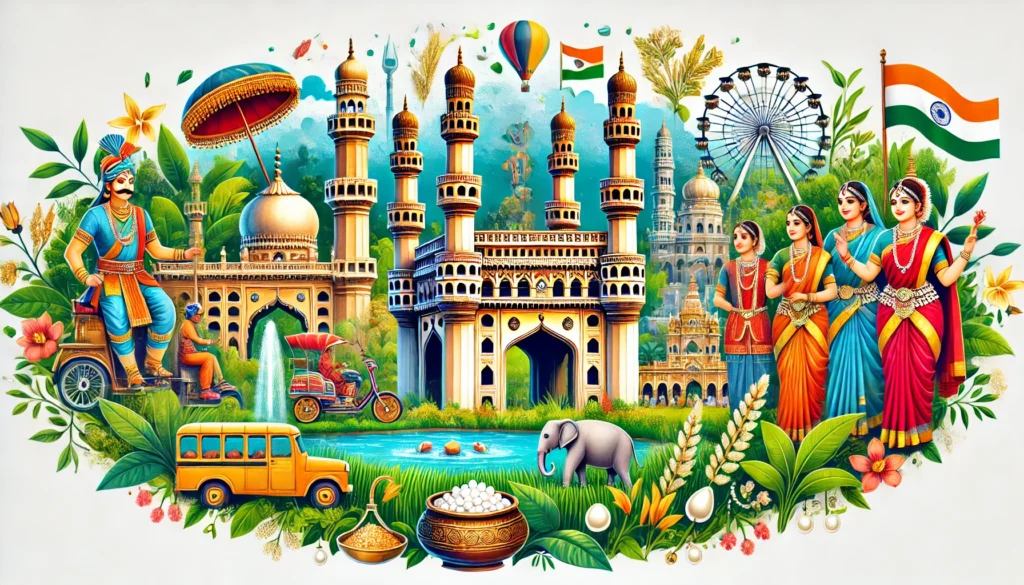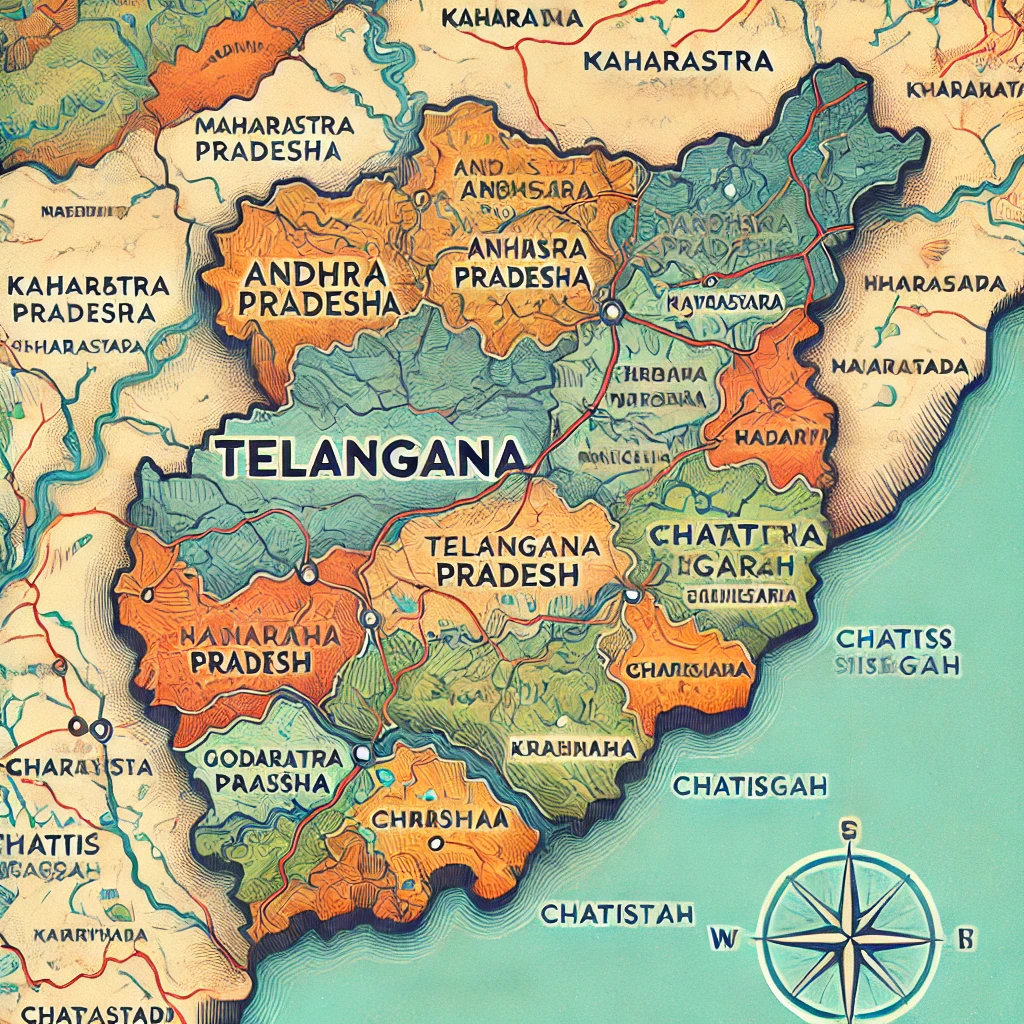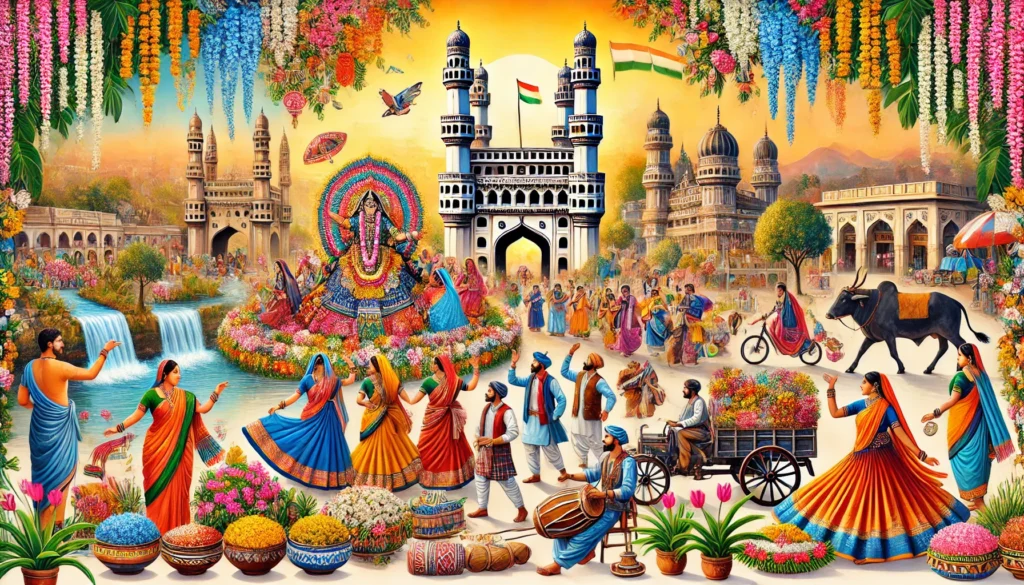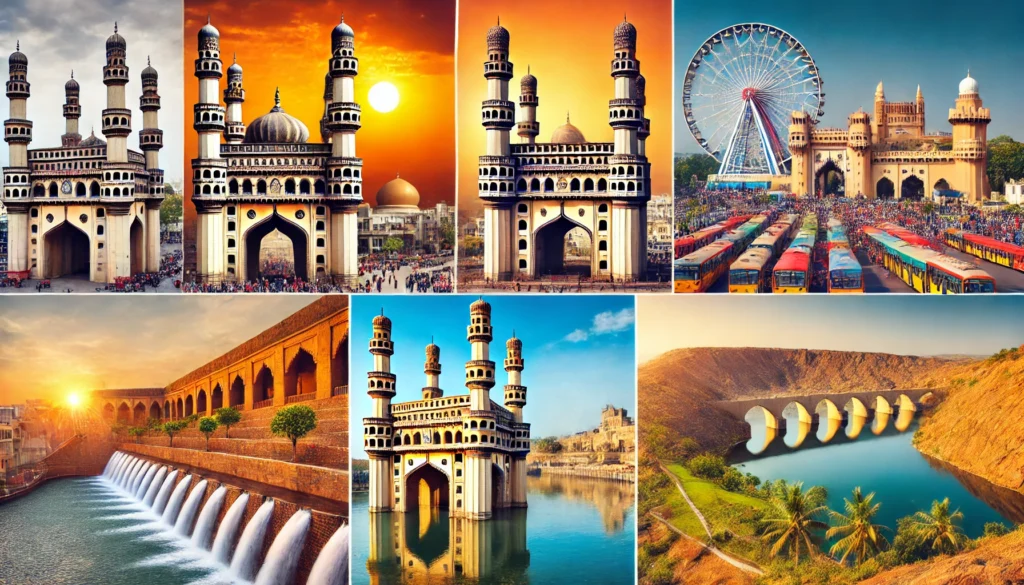
Telangana is the 29th state of India , formed on 2 June 2014 after separation from Andhra Pradesh. The name Telangana is derived from the Telugu language word ” Telang ” , which means Telugu-speaking land. The capital of this state is Hyderabad , which is famous for its historical and cultural importance.
Geographical location
The geographical location of Telangana state is on the Deccan Plateau of South India. It is surrounded by Maharashtra in the north , Chhattisgarh in the north – east , Andhra Pradesh in the east , Karnataka in the south and Goa in the west.
- Total area : 1,12,077 sq km
- Major rivers : Godavari , Krishna , Manjira and Musi.
History
The history of Telangana is quite old and rich. It has been a part of the Maurya , Satavahana , Chalukya , Kakatiya and Qutubshahi empires. Particularly , during the Kakatiya empire, the region advanced greatly in trade , art and architecture. Later it came under the Nizam Hyderabad. After the independence of India, the region became a part of Andhra Pradesh , but after a long struggle, it got the status of a separate state.
administrative structure
- Capital : Hyderabad
- Total Districts : 33
- Governor : The post of Governor is constitutional.
- Chief Minister : Executive head of the state.
- Assembly seats : 119
- Lok Sabha seats : 17
economy
is based on agriculture , industry and service sector.
- Agriculture : Paddy , cotton , chilli and pulses are the main crops.
- Industries : Information technology , pharmaceuticals , textiles and mineral-based industries are the major ones.
- IT Sector : Hyderabad is the IT hub of India and is also known as ” Cyberabad ” .
Culture and Tradition
, dance and folk arts here are unique.
- Folk dance : Perini Shivatandavam , Gusadi.
- Important festivals : Bathukamma , Bonalu , Sankranti , Dussehra.
- Language : Telugu is the main language , while Urdu and Hindi are also spoken.
Tourist Spots
Telangana has many historical , religious and natural places that attract tourists.
- Charminar : The symbol of Hyderabad.
- Golconda Fort : A wonderful example of ancient architecture.
- Ramoji Film City : The world’s largest film city complex.
- Warangal Fort : A symbol of the Kakatiya Empire.
- Yogi Vemana University and other educational institutions .
Key Features
- India’s largest lift irrigation project ” Kaleshwaram Project ” is in Telangana.
- ” Bathukamma ” festival has been included in the UNESCO cultural heritage list.
- Hyderabadi Biryani and Irani Tea are world famous.
conclusion
Telangana is a state known for its cultural diversity , historical heritage and a blend of modernity. The state is rapidly progressing and is making a significant contribution to the economic and cultural development of India.
Geographical location of Telangana

the 11th largest state in the country by area . Its geographical location makes it important from the point of view of agriculture , mineral and water resources.
Status and extent
- Longitude : Between 77° to 81° East longitude.
- Latitude : Between 15° to 19° North latitude.
- boundaries :
- Maharashtra to the north .
- Chhattisgarh in the north – east .
- Andhra Pradesh to the east and southeast .
- Karnataka in the south – west .
Natural terrain
The terrain of Telangana is mainly the Deccan Plateau , which is rich in black and red soil.
- Plateau region : Most of the state is plateau , which is suitable for agriculture.
- River System : The main rivers of Telangana are Godavari and Krishna. Along with these, tributaries like Manjira , Musi and Pranahita also flow here.
- Forest Area :
- About 24% of the state’s area is covered with vegetation.
- Main vegetation : Teak , bamboo , and rosewood.
Soil and minerals
- Soil :
- Black Soil : Suitable for cultivation of cotton and pulses.
- Red soil : Useful for paddy and sugarcane.
- Sandy soil : Helpful in cultivation of fruits and vegetables.
- Minerals :
- Telangana is rich in mineral wealth.
- coal ( Singareni coalfields ), limestone , marble and uranium are found here.
climate
- Type : Mainly tropical climate is found in Telangana.
- Summer : The temperature in summer reaches 40°C to 45°C .
- Winter : In winters the minimum temperature drops to 12°C .
- Rain :
- Average annual rainfall : 750 mm to 1150 mm.
- The main source of rainfall is the south – west monsoon.
Rivers and irrigation
- Godavari River : The longest river in the state , important for agriculture and hydropower.
- Krishna River : The second major river , which provides water to the south – western region.
- Kaleshwaram Project :
- It is one of the largest lift irrigation projects in the world.
- The water of the Godavari River is used for irrigation and drinking water supply.
Natural Resources
Telangana has immense potential for development due to its natural resources.
- Water Resources : Several reservoirs and barrages have been constructed on the Godavari and Krishna.
- Minerals : Mining of coal , limestone and iron ore helps in the industrial development of Telangana.
- Forests and Biodiversity : Many wild animals and medicinal plants are found in the forest areas here.
Geographical Importance
- Agriculture : The land and climate here are suitable for crops like paddy , cotton , chilli , and sugarcane.
- Industrial Development : Abundance of mineral resources and hydropower promotes industrialization.
- Tourism : Hills , waterfalls , and forest areas are tourist attractions.
conclusion
The geographical location of Telangana makes it prosperous from economic , agricultural and industrial point of view. Its rivers , plateau terrain and mineral wealth not only contribute to the self-sufficiency of the state but also play an important role in the overall development of the country.
History of Telangana
The history of Telangana is culturally , politically and socially rich and diverse. The region has been under the rule of many empires and rulers who enriched it with their art , culture and architecture. The modern history of Telangana has witnessed the struggle to become a separate state from Andhra Pradesh.
Ancient period (500 BC – 300 AD )
Asafgarh and Satavahana Empire :
- The Telangana region was an important part of the Satavahana Empire.
- The Satavahana rulers were patrons of trade , especially the Silk Route , and the arts.
- Places like Amaravati and Nagarjunakonda became centres of Buddhist culture.
Maurya Empire :
- During the time of Chandragupta Maurya, parts of Telangana were part of the Maurya Empire.
- propagated Buddhism .
Medieval Period (300 AD – 1700 AD )
Kakatiya Empire (12th – 14th Century ) :
- The Kakatiya Empire has a special place in the history of Telangana.
- Capital : Warangal.
- Major rulers : Ganapati Dev and Queen Rudramma Devi.
- The Kakatiya rulers built several lakes and forts , prominent among them being the Warangal Fort and the Ramappa Temple.
- Kakatiya architecture and water management system is a testimony to their greatness.
Bahmani and Qutb Shahi Empire (14th – 17th centuries ) :
- After the fall of the Kakatiya Empire, the region came under the Bahmani Sultanate.
- Later the Qutb Shahi dynasty made Hyderabad their capital.
- The Charminar and Golconda Fort are marvelous examples of Qutub Shahi architecture.
- The Qutb Shahi rulers were patrons of arts , literature, and trade.
Modern Period (1700 AD – 1947)
Nizam Rule (1724 – 1948) :
- After the fall of the Mughal Empire , the Asaf Jahi dynasty established Nizam rule with Hyderabad as its capital.
- The Nizams made Hyderabad a flourishing cultural centre.
- He was a patron of Persian , Urdu and Telugu literature.
British Rule and Independence of Hyderabad :
- Nizam of Hyderabad was an independent princely state of British India.
- India’s independence (1947) , the Nizam refused to include Hyderabad into the Indian Union.
- In 1948, under ” Operation Polo ” , the Indian Army annexed Hyderabad into India.
Present period (1948- till date )
Formation of Andhra Pradesh (1956) :
- Andhra Pradesh was formed by combining Telugu speaking areas on the linguistic basis.
- Telangana region was included in Andhra Pradesh.
Telangana Movement (1956 – 2014) :
- 1969: Telangana movement started.
- stood up against the economic , cultural and administrative discrimination they faced within Andhra Pradesh .
- 2001: The movement gained momentum with the formation of Telangana Rashtra Samithi ( TRS ) .
- 2014: After a long struggle, Telangana became the 29th state of India on 2 June 2014 .
After the formation of Telangana (2014 – present ) :
- After formation, Telangana experienced rapid growth in agriculture , industry and IT sectors.
- Major schemes like the Kaleshwaram Irrigation Project became milestones in the progress of the state.
- Hyderabad , the capital of Telangana , became India’s major IT and business hub.
Influence of culture and heritage
Telangana’s historical background has made its culture rich and diverse.
- Festivals like Bathukamma and Bonalu symbolize ancient traditions.
- The architecture of the Kakatiya and Nizam period is still the cultural identity of this region.
conclusion
The history of Telangana is a witness to ancient civilisations , the rise and fall of empires , and social movements. The region has created a unique identity in the history of India with its rich cultural heritage and developing modernity.
Administrative structure of Telangana
Telangana is a constitutional state of India , whose administrative structure is based on the federal structure of the Indian Constitution. It has three main organs in the form of executive , legislature and judiciary , which ensure the smooth functioning and administration of the state.
1. Executive
The executive of Telangana is responsible for implementing and executing the administration of the state.
- Governor :
- Constitutional head of the state.
- Appointed by the President of India.
- to approve important bills , dissolve the Assembly and impose emergency in special circumstances.
- Chief Minister :
- The head of the state executive.
- The Chief Minister is selected by the party or coalition having a majority in the state legislative assembly.
- The Chief Minister heads the Council of Ministers.
- Council of Ministers :
- The Chief Minister and his group of ministers.
- Members of the Council of Ministers hold charge of various departments , such as Education , Health , Agriculture , etc.
2. Legislature
The legislature of Telangana is bicameral , which means it consists of two houses :
- Legislative Assembly :
- Number of members : 119 .
- The members of the Legislative Assembly are directly elected by the people.
- The Chief Minister and the Council of Ministers are formed by the party having majority in the Legislative Assembly.
- The Legislative Assembly makes policies and laws for the state.
- Legislative Council :
- This is a permanent house.
- Number of members : 40 .
- Its members are selected partly by the Governor and partly by various bodies.
3. Judiciary
The function of the judiciary of Telangana is to ensure the compliance with the law and the Constitution.
- Telangana High Court :
- The High Court is the highest judicial body of the state.
- It is located in Hyderabad.
- The judges of the High Court are appointed by the President of India.
- District and Subordinate Courts :
- Lower level of the judiciary.
- Civil and criminal cases are heard here.
4. District Administration
Telangana is divided into districts for administrative convenience.
- Total Districts : 33 .
- District Collector :
- Head of the district administration.
- The duties of the District Magistrate are to collect revenue , maintain law and order , and monitor development works.
- Panchayati Raj System :
- Panchayati Raj system is in place for local governance.
- includes Gram Panchayat , Mandal Council and Zilla Parishad.
5. Police and law and order
The police system of Telangana is responsible for maintaining law and order.
- DGP (Director General of Police) : Head of the state police department.
- (SP) at the district level Maintains law and order.
- Cyberabad and Hyderabad Police Monitors special technical and IT – related crimes.
6. Administrative departments and major policies
The Government of Telangana conducts its administration through various departments.
- Important Departments :
- Agriculture and irrigation.
- Information technology.
- Education.
- Health
- Industry.
- Key Policies :
- ” Raitu Bandhu Yojana ” ( Financial assistance to farmers ) .
- ” Mission Bhagiratha ” ( drinking water supply ) .
- ” Kaleshwaram Project ” ( Irrigation Development ) .
conclusion
The administrative structure of Telangana prioritises the development of the state and the welfare of the people in harmony with the central government. It follows an effective system of governance keeping in mind democratic values and local needs.
Economy of Telangana
The economy of Telangana is one of the fastest growing states in India. It is based on agriculture , industry and service sectors. The state’s strategic geographical location , rich natural resources , strong IT base and developed infrastructure are instrumental in its economic progress.
1. Sectoral breakdown of economic contribution
The economy of Telangana is based on three main sectors :
Agriculture and Allied Sectors :
- Contribution to the economy : 20% .
- crops :
- Main crops : Paddy , cotton , sugarcane , and chilli.
- Cash crops : Oilseeds , Tobacco.
- Important Schemes :
- Raitu Bandhu Yojana : Financial assistance to farmers.
- Raitu Bima Yojana : Insurance coverage for farmers.
- Irrigation :
- Irrigation projects based on Godavari and Krishna rivers.
- Kaleshwaram Lift Irrigation Project is one of the largest irrigation projects in the world.
Industry :
- Contribution to the economy : 25% .
- Major Industries :
- Information Technology (IT) :
- Hyderabad is called ” Cyberabad ” .
- Technology hubs : HITEC City and Genome Valley .
- IT Companies : Google , Microsoft , Facebook , Amazon etc.
- Pharmaceutical and Biotechnology :
- ” Pharma Capital ” of India .
- Major companies : Dr. Reddy’s , Biocon , and Apollo.
- Mineral Based Industries :
- Coal ( Singareni coal mines ), limestone and marble.
- Information Technology (IT) :
- Industrial Parks and Special Zones :
- T – Hub : Innovation centre for startups.
- Pharma City and Textile Park.
Services Sector :
- Contribution to the economy : 55% .
- Information Technology :
- In 2023 , IT exports from Telangana stood at over ₹1.8 lakh crore.
- Tourism and Hospitality Industry :
- Historical sites ( Charminar , Golconda ), film cities ( Ramoji Film City ) and cultural events generate major revenue for the state.
- Financial Services :
- Banking and insurance services also contribute significantly.
2. Revenue source of the state
Telangana’s revenue mainly comes from the following sources :
- Tax Revenue :
- Goods and Services Tax (GST), excise duty , and stamp duty.
- Non – Tax Revenue :
- Income from mineral wealth.
- Revenue from electricity and water supply services.
- Grants from Central Government :
- For plans and projects.
3. Contribution of agriculture and irrigation
- Agriculture :
- 60% of Telangana’s area is dependent on agriculture.
- Crop diversity : cereals , pulses , and cash crops.
- Irrigation :
- Godavari and Krishna rivers These are the major water streams of the state.
- Kaleshwaram Project and Mission Kakatiya There are milestones in the field of irrigation.
4. Progress of the industrial sector
- Pharma and Biotechnology :
- Hyderabad is India’s major pharma and biotechnology hub.
- Information Technology :
- In 2023 , more than 500 multinational companies offered their services in Hyderabad .
- The state is a leader in IT exports.
- Textiles and Handicrafts :
- Pochampalli saree and handloom industries are world famous.
5. Development of service sector
- Tourism :
- Revenue from tourist places : Charminar , Ramoji Film City , Warangal Fort.
- Cultural festivals like Bathukamma attract tourists.
- Education and Health :
- Higher Education Institutions : Indian Institute of Technology (IIT), University of Hyderabad.
- Health : Apollo and other major hospitals.
6. Developments and plans
- Raitu Bandhu Yojana : Financial assistance for farmers.
- Mission Bhagiratha : Supply of clean drinking water to every household.
- Mission Kakatiya : Revival of traditional water reservoirs.
- IT Hub : Promoting startups and multinational companies.
7. Major Challenges
- Agricultural Crisis :
- Dependence on rain.
- Farmers’ loan.
- Urbanisation :
- Managing infrastructure in rapidly growing urban areas.
- Uneven development :
- Economic inequality between rural and urban areas.
8. Future Prospects
- Continued investments in IT and Pharma industries.
- More technological advancement in agriculture.
- Expansion in the field of tourism and handicrafts.
- Rural development through infrastructure projects.
conclusion
The economy of Telangana is based on a balance of agriculture , industry, and service sectors. The state has experienced rapid growth since its formation and has contributed significantly to India’s economy through its plans , projects , and efficient management of resources.
Culture and Tradition of Telangana

The culture and tradition of Telangana is a reflection of its rich historical background , the influence of various rulers , and vibrant folk traditions. The region is known for its unique art , dance , music , literature , cuisine , and festivals. The cultural diversity of Telangana makes it one of the most colorful and fascinating states of India.
1. Historical and cultural heritage
has been deeply influenced by various empires such as the Satavahana , Kakatiya , Bahmani , Qutb Shahi , and Nizam rule.
- Kakatiya Empire :
- Architecture : Ramappa Temple , Warangal Fort.
- Water management system : Construction of lakes and ponds.
- Qutb Shahi and Nizam Rule :
- Persian , Urdu , and Telugu literature.
- Architectural marvels like the Charminar and Golconda Fort.
2. Language and Literature
- Languages :
- Telugu is the official language of the state.
- Urdu is also widely spoken and written.
- Literature :
- Telugu literature includes great poets like Kavi Kannandeshwar , Mallikarjuna Pandit.
- – o – Shayari and poems in Urdu flourished during the Nizam period .
3. Arts and Crafts
- Handicrafts :
- Pochampalli Sarees : A symbol of the weaving art of Telangana.
- Bidri work : Metal carving , especially famous in Hyderabad.
- Wood Carvings and Toys : Carved wooden products.
- drawing :
- Telangana paintings depict mythological and folk tales.
4. Dance and music
- dance :
- Perini Shivatandava :
- Ancient war dance , dedicated to Shiva.
- This dance dates back to the time of the Kakatiya Empire.
- Bonalu Dance :
- Folk dance performed by women during festivals.
- Perini Shivatandava :
- music :
- The music of Telangana is a combination of traditional folk music and classical music.
- Oggu Katha : This is a traditional singer katha in which religious stories are sung.
5. Festivals and Celebrations
Festivals in Telangana are celebrated as a symbol of cultural richness and social harmony.
- Bathukamma :
- This is a festival of flowers , dedicated to Goddess Gauri.
- Women prepare a puja thali decorated with flowers and sing songs and dance.
- Bonalu :
- A major festival dedicated to Goddess Mahakali.
- Women go to temples carrying decorated plates to offer to the goddess.
- Ramoji Film City Festival :
- A grand festival of films and cultural programmes.
- Solstice :
- A harvest festival , celebrated especially in rural areas.
6. Food and Drink ( Dishes )
Telangana cuisine is famous for its spicy and delicious dishes.
- Main dishes :
- Hyderabadi Biryani.
- Sarva Pachadi ( Lentil and Sesame Chutney ) .
- Pulihora ( Tamarind Rice ) .
- Sweets :
- Cashew katli.
- Polelu ( fragrant stuffed paratha ) .
- Drinks :
- Irani tea is a staple drink of Hyderabad.
7. Religion and spirituality
Religious tolerance and confluence of different religions can be seen in Telangana.
- Hinduism :
- Major religious places like Yadadri Temple and Bhadrachalam Temple.
- Islam :
- Mecca Masjid and Charminar.
- Buddhism :
- Buddhist Monuments at Nagarjunakonda and Amaravati.
8. Films and Entertainment
- is the centre of the Telugu film industry ( Tollywood ) .
- Ramoji Film City is the largest film studio in the world.
9. Costumes
- Traditional costumes of women :
- Sarees , especially Pochampalli and Gadhwal saris.
- Traditional costumes of men :
- Dhoti and kurta.
10. Tribal culture
Gond , Koya and Lambadi live in Telangana.
- are famous for their unique traditions , dances , and art.
- The folk songs and dances of the Gond tribe add to the cultural diversity of Telangana.
conclusion
The culture and tradition of Telangana is a reflection of its rich historical heritage and vibrant folk life. Its unique traditions and festivals not only promote regional integration but also make it a significant contributor to the cultural diversity of India.
Major tourist places in Telangana

Major tourist places in Telangana is famous for its historical heritage , cultural diversity , and natural beauty. The state offers a confluence of religious places , historical forts , lush green forest areas , and modern technological structures for tourists.
1. Historical Places
Charminar ( Hyderabad ) :
- 1591 by Sultan Muhammad Quli Qutb Shah of the Qutb Shahi dynasty.
- It is a monument with four grand minarets.
- Charminar is a symbol of the cultural identity of Hyderabad.
Golconda Fort ( Hyderabad ) :
- Headquarters of the Qutb Shahi empire.
- Famous for its sound engineering and architecture.
- The light and sound show here attracts tourists.
Ramappa Temple ( Warangal ) :
- UNESCO World Heritage Site.
- Built by the Kakatiya dynasty, this temple is famous for its exquisite carvings and architecture.
Warangal Fort ( Warangal ) :
- A symbol of the grandeur of the Kakatiya Empire.
- Stone carvings and archway are its main attractions.
2. Religious places
Yadadri Temple ( Bhongir ) :
- This temple dedicated to Lord Lakshmi Narasimha is situated on the hill.
- It is also called ” Tirupati of Telangana ” .
Bhadrachalam Temple ( Bhadradri Kothagudem ) :
- This temple dedicated to Lord Rama is situated on the banks of Godavari River.
- This place is famous for the mythological events related to Ramayana.
Chilkur Balaji Temple ( Hyderabad ) :
- It is also known as ” Visa Balaji Temple ” .
- Devotees believe that worshipping here helps in getting visa for travelling abroad.
Mecca Masjid ( Hyderabad ) :
- One of the oldest and largest mosques in India.
- It was built during the Qutb Shahi dynasty.
3. Natural sites
Kotpalli Falls ( Adilabad ) :
- A beautiful waterfall , which becomes even more attractive during monsoon.
Nagarjuna Sagar Dam ( Nalgonda ) :
- This is the largest dam in India.
- – tourism here attract tourists.
Pakal Lake ( Warangal ) :
- Famous for its greenery and serene environment.
- This lake is an ideal place for bird lovers.
Annaram Wildlife Sanctuary ( Mahboobnagar ) :
- This sanctuary is famous for various flora and fauna .
4. Modern structures and sites
Ramoji Film City ( Hyderabad ) :
- The largest film studio in the world.
- is famous for film shooting , cultural programs , and entertainment.
Hussain Sagar Lake ( Hyderabad ) :
- A huge statue of Lord Buddha is situated in the middle of this lake.
- Boating and water sports can be enjoyed here.
Nehru Zoological Park ( Hyderabad ) :
- Spread over 380 acres, this park is famous for various species of animals .
Cyber Towers ( Hyderabad ) :
- It symbolizes the IT hub of Hyderabad.
- From here one can see the modern technological progress of the city.
5. Rural and tribal tourism
Eternagaram Wildlife Sanctuary ( Jaishankar Bhoopalpally ) :
- This sanctuary is famous for tigers , deer and other wildlife.
- Trekking and jungle safari can be enjoyed.
Medaram Jatra ( Mahabubabad ) :
- This is the biggest tribal festival of India.
- The goddesses worshipped are Samakka and Sarakka.
6. Cultural and Educational Sites
Salarjung Museum ( Hyderabad ) :
- It is one of the largest museums in India.
- displays ancient paintings , sculptures , and other historical objects.
B. M. Birla Planetarium ( Hyderabad ) :
- A prime destination for astronomy and science lovers.
Kuchipudi Dance Schools :
- Famous for teaching and preserving the tradition of Kuchipudi dance in Telangana.
7. Unique and hidden gems
Bhongir Fort ( Bhongir ) :
- Situated on a hill, this fort is an ideal place for trekking lovers.
Vemulawada Temple ( Rajanna Sircilla ) :
- Lord Raja Rajeswara ( Shiva ) , this temple is a major centre of attraction for local devotees.
8. Telangana tourism industry and schemes
The Telangana government has launched various schemes to promote tourism , such as :
- ” Haritha Resorts ” : A place to stay for tourists with modern facilities.
- ” Telangana Tourism ” App and Portal : Guide and booking facility for tourists.
- Conservation of forests and wetlands to promote eco – tourism.
conclusion
Telangana is an ideal place for tourism due to its diversity of historical , cultural and natural sites. The state not only attracts history buffs and religious travelers , but is also an important destination for nature lovers and modern travelers.
